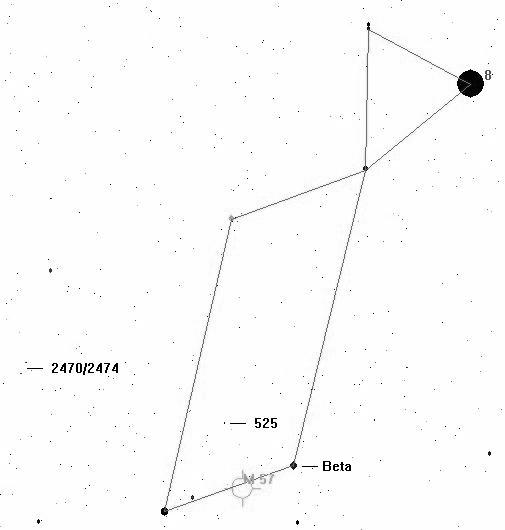Unfamiliar Lyra
Jack Kramer
Everyone knows about the Ring Nebula (M57) in the constellation Lyra - most of us can find it without consulting a star chart. And quite a few are acquainted with the Double-Double (Epsilon Lyrae), which is a good multiple star system for testing the quality of your telescope optics. But there's another, less familiar facet to Lyra.
It began with Leon Fasano at the June LCAS member star party in Hebron. He came without his telescope; but equipped with star charts, he embarked on a night of mischief by suggesting things for the rest of us to look at. Among those items was a whole bunch of double stars in Lyra. If you check a good star chart, you'll see many double star symbols there; some are true doubles that are gravitationally bound and others are visual doubles - just chance alignments of stars. Until Leon pointed out all these doubles, I had never paid much attention to this aspect of Lyra.
The following chart (adapted from the Guide V8.0 program) shows three of the more interesting multiple star systems. Some identifiers are "Struve" numbers, which are commonly used to identify double stars, and are prefixed with the Greek Sigma symbol (Ó) for F.G.W.Struve or listed as "OÓ" for Otto Struve.
 OÓ525 is a double that shows a nice color contrast. One component is yellow and the other blue.
OÓ525 is a double that shows a nice color contrast. One component is yellow and the other blue.Ó2470 and Ó2474 is the "other" double-double in Lyra. The colors are white and blue-white in 2470 and pale yellow in 2474.
Beta Lyrae (â) is an eclipsing binary star listed as a variable, inasmuch as the mutual eclipsing of the two components causes brightness fluctuations in the system. The faint secondary has not been seen directly, but identified through spectroscopy and photometry. The two stars are so close to one another that it's believed they are distorted and connected by a filament of streaming matter. Beta is also a multiple star system with companions of magnitude 7.8, two at 9.9, and two at 13.0. The 7.8 and one of the 9.9 magnitude stars seem to be physical members of the system, while the others are merely visually aligned with the system.
Actually, Vega (the 5th brightest star in the sky) is also a visual multiple star system with a 10th magnitude companion and another at 12th magnitude. The brighter companion can usually be seen in a 6-inch scope.
Check over your star chart for a lot of other multiple stars in Lyra. How many can you round up with your scope? One of these nights I'm going to take a look at some of the others that I didn't get around to at the June star party. And thank you Leon!
Puished in the July 2002 issue of the NightTimes




